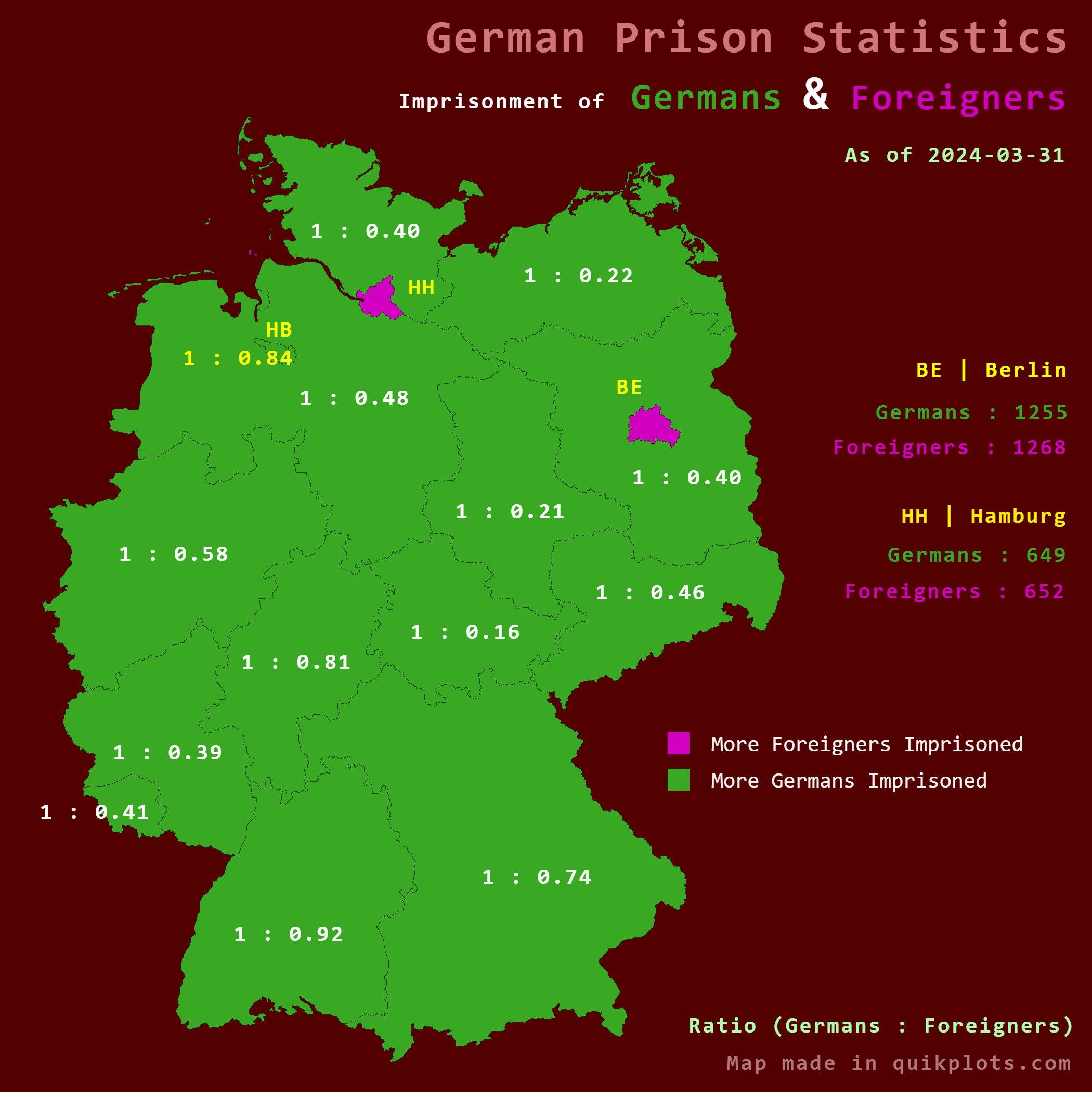Map of Foreigners Outnumbering Germans in Prisons


Marcus Rodriguez
Historical Geography Expert
Marcus Rodriguez specializes in historical cartography and geographic data analysis. With a background in both history and geography, he brings unique...
Geographic Analysis
What This Map Shows\nThis map provides a visual representation of the demographic distribution of prisoners in German jails, specifically highlighting regions where foreigners outnumber German nationals. By depicting data from various Länder and Kreisfreie Städte, the map gives us a clearer understanding of the complex interplay between nationality and incarceration rates in Germany. It is essential to note that this visualization specifically focuses on adults in imprisonment and does not account for youth custody or preventive detention, thus honing in on a particular segment of the penal system.
Deep Dive into Nationality and Incarceration in Germany\nThe topic of incarceration in any country often reflects broader social dynamics, including migration, economic opportunity, and cultural integration. In Germany, the issue of foreigners in prisons has gained significant attention over the years. According to recent statistics, a substantial number of prisoners in Germany are non-German nationals. This trend can be attributed to various factors, including immigration patterns, socio-economic status, and intercultural relations.
Interestingly, the foreign-born population in Germany is diverse, comprising individuals from various backgrounds and countries. This diversity is reflected in the prison demographics, where individuals from regions such as Eastern Europe, North Africa, and the Middle East are among the most represented groups. Have you noticed that some regions show strikingly higher ratios of foreign prisoners compared to Germans? This could be indicative of both localized crime rates and the socio-economic challenges faced by immigrant communities.
For instance, cities like Berlin and Frankfurt exhibit noteworthy figures, where the ratio of foreign inmates surpasses that of their German counterparts. Factors such as urbanization, economic disparity, and even the presence of organized crime may contribute to these figures. According to the Genesis database, which provides foundational data for this visualization, certain areas report alarming rates of incarceration among foreign nationals, raising questions about societal integration and the legal system's approach to justice.
Furthermore, it's crucial to consider that the criminal justice system does not operate in a vacuum. The experiences of foreigners in German prisons are often influenced by their legal status, language barriers, and access to resources. What's fascinating is how these variables can shape outcomes in terms of rehabilitation and recidivism. Many foreigners face systemic challenges that may lead to higher incarceration rates, particularly in economic hubs where crime often correlates with poverty and lack of opportunity.
Regional Analysis\nDiving deeper into the map, we can see that the Länder of North Rhine-Westphalia and Bavaria present stark contrasts in their incarceration demographics. In North Rhine-Westphalia, the urban centers, with their significant immigrant populations, often report higher rates of foreign inmates. This is particularly evident in cities like Düsseldorf and Cologne, where social challenges are more pronounced. Conversely, in Bavaria, while there are still notable foreign populations, the overall rate of foreigners in prisons is relatively lower, suggesting differing regional policies or community dynamics.
The map also highlights discrepancies in smaller Kreisfreie Städte, where localized factors can dramatically influence imprisonment rates. For example, regions that have seen recent surges in immigration might experience higher foreign incarceration rates as communities grapple with rapid demographic shifts. Each area tells a unique story, influenced by local law enforcement practices, community support systems, and social integration initiatives.
Significance and Impact\nUnderstanding the dynamics of foreign incarceration in Germany is crucial for several reasons. Firstly, it sheds light on the broader implications of immigration policy and social integration strategies. As Germany continues to navigate the complexities of a multicultural society, addressing the root causes of crime among foreign nationals becomes paramount. Effective rehabilitation programs and community support can significantly impact reducing recidivism rates and fostering a more cohesive society.
Moreover, this issue is not just about numbers; it has real-world implications for families and communities. The stigma associated with being an incarcerated foreign national can lead to cycles of poverty and social exclusion. Therefore, grappling with these statistics is essential for policymakers to create informed responses that promote justice and equality.
In conclusion, this map is more than just a visualization of data; it reflects the intricate tapestry of German society and the ongoing challenges of immigration, integration, and justice. As we move forward, it is vital to continue monitoring these trends and advocate for policies that encourage inclusivity and understanding within the framework of the law.
Visualization Details
- Published
- October 16, 2025
- Views
- 18
Comments
Loading comments...